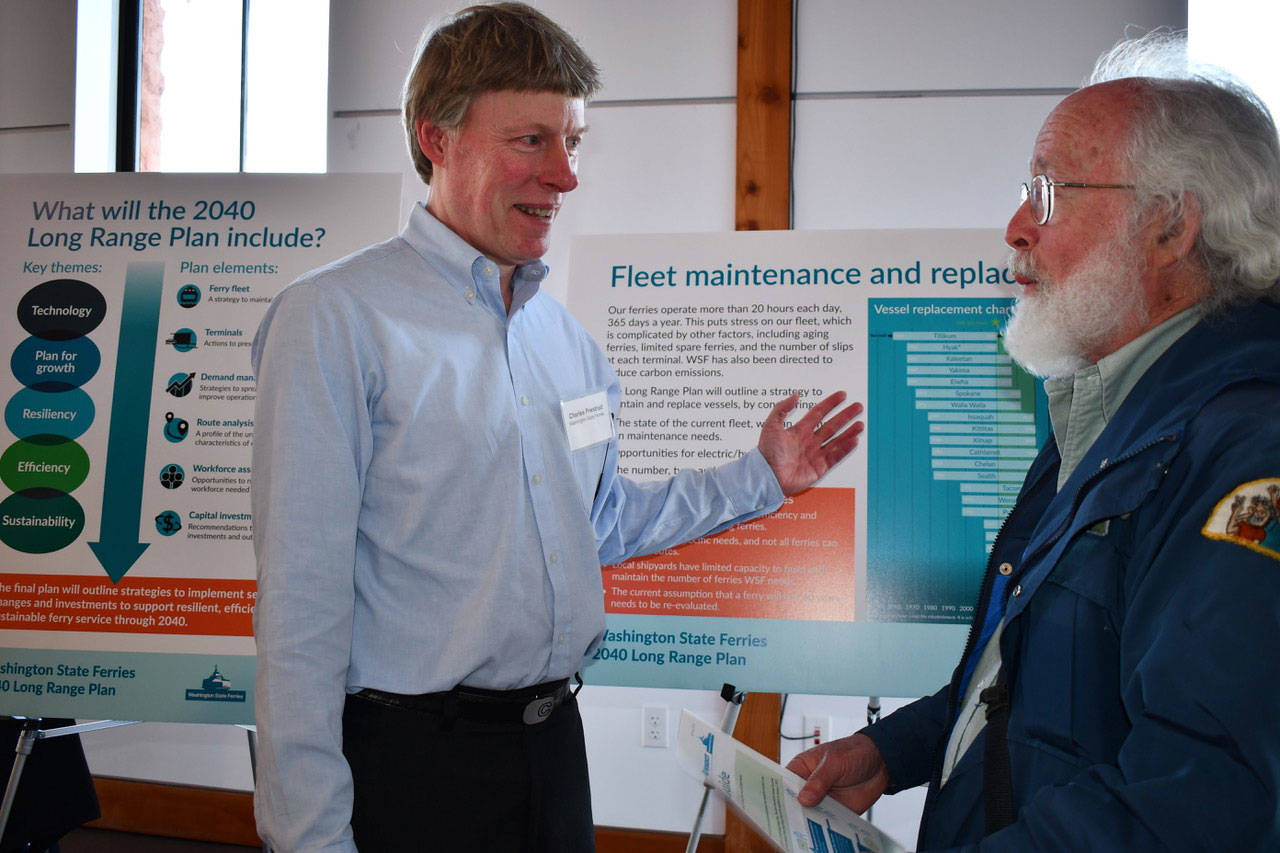PORT TOWNSEND — The state Department of Transportation and Washington State Ferries want your help in shaping the next 20 years of the region’s waterway transit system.
But don’t expect too many changes to the Port Townsend-Coupeville route.
Members of the Washington State Ferries (WSF) 2040 Long Range Plan team were on hand to field questions and review data during a two-hour outreach session Thursday at the Cotton Building.
They are looking to residents and ferry users to help identify priorities and considerations that should be included in the plan.
“This is one of the open houses we’re holding throughout the system to introduce our long range planning process,” explained Hadley Rodero, strategic communications manager for WSF. “The first meeting was held on Bainbridge Island, this is our second. There will be seven more over the course of next month.”
Rodero explained that the resulting plan will be the blueprint for the next 20 years, through 2040. Data collected will analyze anticipated growth, ridership forecasts and what needs to be done to manage and serve that growth.
Rodero said WSF is looking at the age of its vessels, what kind of vessel maintenance needs to be planned and whether the system needs new vessels and on what routes.
They will identify terminal improvements, and they’ll look at other issues including sustainability and planning for events such as climate change.
“What we’re focusing on right now is existing routes,” Rodero said. “Adding a Seattle to Port Townsend route doesn’t seem likely. One of the elements is obviously cost and funding. We’re looking at what can we afford, and what the priorities are. “
“Tonight I’ve heard a lot of interest in greening the fleet. There are a few posters in here that explain converting our vessels to hybrid electric power. Gov. [Jay] Inslee said recently that we’ve built our last diesel ferry. We’re looking at alternatives for the future.”
A WSF technical advisory group that includes representatives from all the transit agencies that connect with the ferry system has been meeting since last summer.
“One of the other strategies we’re looking at is better connection to transit, more parking at terminals, and working with car sharing and bike sharing companies as they are an extension of transit,” Rodero said.
Ray Deardorf, WSF senior planning manager, said that the Port Townsend-Coupeville route won’t see any significant changes, even though ridership currently exceeds its level of service standard.
“This PT-Coupeville route requires a specific size boat and maneuverability characteristics because of the narrowness and the shallowness of Keystone Harbor in Coupeville,” Deardorf said.
“These vessels were designed back in the last decade and built quickly. They were a proven design from the East Coast and adapted for this route.
“Initially they had a list, but that has been corrected.
“They are functioning quite well and have high clearance for trucks. The truck traffic on this route has mushroomed compared to the older vessels we had. This route has been growing pretty substantially.
“The three vessels that serve this route are some of the newest ferries so I don’t think that during the horizon of this plan they will have to be replaced. Our plan is to continue to use these ferries on this route and concentrate on other vessels that are 50-60 years old.”
Deardorf said that Port Townsend-Coupeville already has a reservation system that has proven to be quite successful.
“What other demand management tools are there besides building new ferries? We can’t accommodate all the vehicle growth. There’s a finite space on each boat. Reservations are one idea,” he said.
“One of the things we’re also working on is door-to-door rather than shore-to-shore. How long does it take to get to your final destination? What are the options and where are the gaps?
“What do we need to do to fill those to make it easier for people to get around without their cars?”
Deardorf admitted that the number of ferries that need to be replaced is concerning. The oldest boat in the fleet, the Tillikum — now a service relief vessel — was built in 1959.
“We want to point out that 13 of the 23 vessels serving our routes have to be replaced by 2040, and some of them are very large vessels,” he said.
“We assume that ferry vessels will last for 60 years. We’ll have to examine the opportunities for electric/hybrid ferries and the number, type and size of the new vessels.”
According to a use analysis, in 2017, 334,300 vehicles traveled the Port Townsend-Coupeville route, both west and eastbound, along with 118,500 walk-on passengers. Projections for the service in 2040 show 498,200 vehicles (an increase of 49 percent) and 185,500 walk-ons (an increase of 56 percent).
The total number of riders on the route in 2017 was 796,400. In 2040, ridership is estimated to be 1,220,000, an increase of 53 percent.
WSF will compile all the suggestions collected, then draft the long-range plan that will be published in September. Another series of community meetings will be held, again asking for comments during a 45-day window.
The final plan is due to be presented to the Legislature by Jan. 1, 2019.
For more information, and to comment, visit the online open house at www.WSFLongRangePlan.com and participate by May 24.
________
Jefferson County Editor/Reporter Jeannie McMacken can be reached at 360-385-2335 or at jmcmacken@peninsuladailynews.com.

